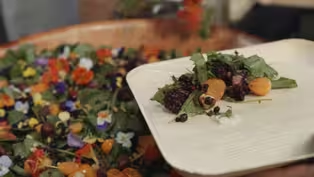
Learn How To Make Sumac Lemonade
Special | 3mVideo has Closed Captions
Sumac berries lend themselves for a lemony-earthy flavored spice or in a beverage.
Sumac berries lend themselves to use in a lemony-earthy flavored spice, or use them immediately to make a tangy and refreshing beverage. Chef Nico Albert (Cherokee Nation) is a self-taught chef, caterer and student of traditional Indigenous cuisines based in Tulsa, Oklahoma.
Problems playing video? | Closed Captioning Feedback
Problems playing video? | Closed Captioning Feedback
Funding is provided by Partnership with Native Americans.

Learn How To Make Sumac Lemonade
Special | 3mVideo has Closed Captions
Sumac berries lend themselves to use in a lemony-earthy flavored spice, or use them immediately to make a tangy and refreshing beverage. Chef Nico Albert (Cherokee Nation) is a self-taught chef, caterer and student of traditional Indigenous cuisines based in Tulsa, Oklahoma.
Problems playing video? | Closed Captioning Feedback
How to Watch Native America
Native America is available to stream on pbs.org and the free PBS App, available on iPhone, Apple TV, Android TV, Android smartphones, Amazon Fire TV, Amazon Fire Tablet, Roku, Samsung Smart TV, and Vizio.
Buy Now

Listen to Native Voices
Explore an interactive map, which features speakers of Native languages in their own voices from across North America.Providing Support for PBS.org
Learn Moreabout PBS online sponsorshipMore from This Collection
Celebrate the history, culture, and traditions of American Indians through these recipes.
Video has Closed Captions
Make a salad of all Native greens from the oak woodlands. (4m 33s)
Video has Closed Captions
Learn how to make this staple dish, which is part of nearly every meal in a Cherokee home. (3m 45s)
Providing Support for PBS.org
Learn Moreabout PBS online sponsorship(gentle instrumental music) - So they're gonna be like lemonade?
- Mm-hm, it's gonna be kind of tangy, kind of sweet and it'll be kind of light pink from the red color of the berries.
- [Chloe] Ooh, light pink, my favorite color.
(Nico laughs) - My name is Nico Albert, I'm a Cherokee Nation citizen and I'm a chef here in Tulsa, Oklahoma.
Today, I'm taking my step-daughter Chloe to an urban wilderness area and we're gonna go pick some sumac to make Indian lemonade.
It's incredibly important to pass these recipes and these food traditions down to future generations.
Food is so strongly tied to memory.
When you sit down at a table and you eat certain foods, you can remember those foods that you ate as a child.
And these foods that we're making are memories from the generations before us and they'll carry on to generations in the future.
(light-hearted percussive music) I picked this wild sumac today to make what we call Indian lemonade or sumac lemonade.
The Cherokee people are originally from the Eastern Woodlands area.
With the Trail of Tears, they were removed to Oklahoma, which at the time was Indian territory.
They were put into a new land where they were not finding the same plants that they were accustomed to.
But there are still some similarities in what you can find in the wild here in Oklahoma, one of those things is sumac.
So the outside of this berry, has a red shell that has a little bit of a fuzz on it, and that has this really tangy astringent kind of flavor.
And so when you soak it with water, it creates this beautiful, tangy, refreshing drink.
(light-hearted percussive music) (light-hearted percussive music) (water splashing) And I'm just sweetening this with a little bit of honey.
And this'll take a little bit of the edge off the really tart flavor that these berries add.
(spoon clanging) (water burbles) (water burbles) (light-hearted percussive music) And that's sumac lemonade.
(ice rattles) Yeah, that's good.
Okay, here ya go.
Alright, cheers.
Sumac lemonade.
(Chloe giggles) (light-hearted percussive music)
Support for PBS provided by:
Funding is provided by Partnership with Native Americans.















